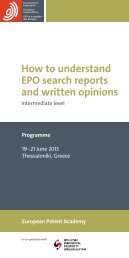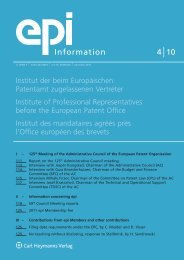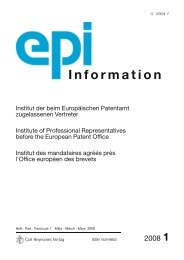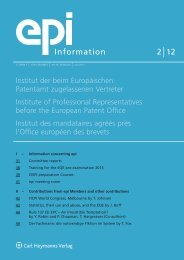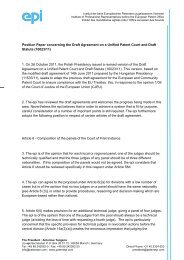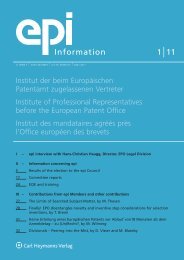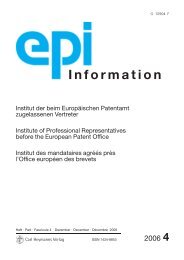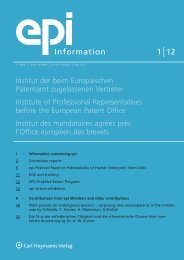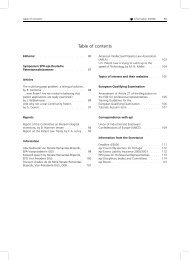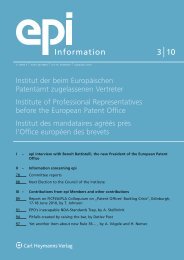epi Information 2/2009
epi Information 2/2009
epi Information 2/2009
You also want an ePaper? Increase the reach of your titles
YUMPU automatically turns print PDFs into web optimized ePapers that Google loves.
<strong>Information</strong> 2/<strong>2009</strong> Articles 67<br />
encompasses (i. e. is broader than) the claim of the<br />
parent is on this basis considered an objectionable<br />
double patenting.<br />
Furthermore, In view of the discussion in T 307/03 in<br />
reasons 5.4 where it is stated:<br />
„To avoid this objection of double patenting the appellants<br />
would have had to confine the claimed subjectmatter<br />
in the present application to subject matter not<br />
already patented in the patent granted on the parent<br />
application. This would then allow the examination<br />
procedure to focus on the question of whether this<br />
claimed subject-matter (for which there is not already<br />
a granted patent) meets the requirements of Articles<br />
123(2) and 83 EPC, as well as the other requirements of<br />
the EPC.“<br />
scenario b) also seems to meet an objection of double<br />
patenting, as here the divisional tries to protect subject<br />
matter already patented in the parent.<br />
This wording of T 307/03 may even suggest that<br />
scenario d) would also objectionable, as the claim put<br />
forward in the divisional (partly) claims subject matter<br />
which is already patented in the parent (intersection of<br />
the two circles). In view of the fact that this partial<br />
overlap is however a common situation in case of nonunity,<br />
where dependent claims of a parent and the<br />
divisional often relate to the same subject matter, this<br />
should probably not be the case. Unfortunately T 307/03<br />
in reasons 5.4 casts doubt on that issue.<br />
It is submitted that double patenting exists, quite<br />
probably as intended by the authors of GL C VI 9.1.6,<br />
when, given identity of patentee and date, two patents<br />
exert the same scope of protection, in the sense that<br />
what comes within the scope of one comes within the<br />
scope of the other, both ways.<br />
This is the effect of S18(5) UKPA 1977, which reads:<br />
„Where two or more applications for a patent for the<br />
same invention having the same priority date are filed by<br />
the same applicant or his successor in title, the comptroller<br />
may on that ground refuse to grant a patent in<br />
pursuance of more than one of the applications.“<br />
because additionally, S 125(1) UKPA 1977 provides<br />
that:<br />
„…an invention…shall…be taken to be that specified in<br />
a claim…“.<br />
That is, an equivalence is established between invention<br />
and claim in a way that is never done in the EPC. It<br />
follows that the effect of S18(5) is to prevent the grant of<br />
two patents of the same ownership and date having the<br />
same claims. Even though there could in some circumstances<br />
still be room for argument about what is „the<br />
same“, it is clear that the provision is extremely limited.<br />
Taking this as our definition of double patenting, can it<br />
be prevented in the EPO?<br />
The Board in T 0587/98 noted that legislation would<br />
be needed to prevent what it called „overlap“. 13 And the<br />
Enlarged Board referred to double patenting in G 1/05,<br />
13 See T0587/98, reasons 3.4<br />
the Divisional decision. It shared the universal acknowledgement<br />
when it said, at Reasons 13.4;<br />
„The Board accepts that the principle of prohibition of<br />
double patenting exists on the basis that an applicant has<br />
no legitimate interest in proceedings leading to the grant<br />
of a second patent for the same subject matter if he<br />
already possesses one granted patent therefor“.<br />
This obiter observation sits at first sight oddly in a<br />
decision in which in the very next paragraph the Board<br />
said (emphasis added);<br />
„On Article 76(1) and Rule 25 EPC as presently worded<br />
the Enlarged Board of Appeal sees no adequate basis for<br />
defining any additional requirements to be imposed on<br />
divisional applications beyond the requirements that all<br />
applications have to fulfil as well.“<br />
In other words, if there is no statutory prohibition, it<br />
must be let go. But then we look again at the first quoted<br />
passage; there is only a principle of prohibition, not an<br />
actual prohibition in the EPC.<br />
The Enlarged Board no doubt had in mind the provisions<br />
of Article 52(1);<br />
„European patents shall [i. e. must] be granted for any<br />
inventions, in all fields of technology, provided that they<br />
are new, involve an inventive step and are susceptible of<br />
industrial application“.<br />
Our double patenting application meets all of those<br />
criteria, and therefore must be granted.<br />
What is the vice?<br />
Why would it be Bad to allow such patents? The usual<br />
answer is that there would be „Double Prejudice“; that<br />
is, a defendant having successfully defended himself<br />
against a charge of infringement finds himself being<br />
sued again by the same patentee in respect of the same<br />
infringement, but this time under his second, „double“,<br />
patent.<br />
Consider the Article 54(3) scenario above, and assume<br />
that an infringer is within the scope of both patents.<br />
Nothing prevents the patentee from suing under only<br />
one of them and then, having failed for some reason,<br />
suing in respect of the same infringement under the<br />
other. If both actions were within the same country a<br />
Court might find that abusive, but the patents are<br />
verbally distinct and there could theoretically be separate<br />
issues. And if the actions were in different countries, as<br />
might very well be possible since the patents are distinct,<br />
there seems to be even less likelihood of the second<br />
action being stopped – at least until there is a common<br />
European Patents Court. This is in substance „Double<br />
Prejudice“; so why is that raised as an objection only<br />
against „double“ patents?<br />
„Absence of legitimate interest“ is probably subsidiary<br />
to the above, but nevertheless it must be observed that<br />
the Enlarged Board in G 3-4/97 gave no indication that<br />
interest, in the sense of locus standi, had any applicability<br />
in the context of the EPC. And any idea that the EPO<br />
should enquire as to the „interest“, in the sense of the



